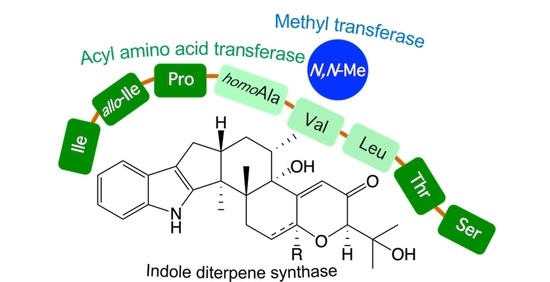Noonindoles A–F: Rare Indole Diterpene Amino Acid Conjugates from a Marine-Derived Fungus, Aspergillus noonimiae CMB-M0339
Abstract
1. Introduction
2. Results
3. Materials and Methods
3.1. General Experimental Procedures
3.2. Fungal Isolation and DNA Taxonomic Analysis
3.3. Global Natural Product Social (GNPS) Molecular Networking
3.4. MATRIX Cultivation Profiling
3.5. Scale Up Cultivation and Fractionation
3.6. Characterization of Metabolites 5–14
- noonindole A (5); pale yellow solid; [α]D21–18 (c 0.02, MeOH); NMR (600 MHz, methanol-d4), see Table S2 and Figures S10–S15; HRMS (ESI) m/z: [M+H]+ calcd for C34H47N2O6 579.3429; found 579.3456.
- noonindole B (6); white solid; [α]D21–13 (c 0.08, MeOH); NMR (600 MHz, methanol-d4), see Table S3 and Figures S17–S22; HRMS (ESI) m/z: [M+H]+ calcd for C33H45N2O6, 565.3272; found 565.3292.
- noonindole C (7); white solid; [α]D21–9 (c 0.06, MeOH); NMR (600 MHz, methanol-d4), see Table S4 and Figures S24–S29; HRMS (ESI) m/z [M+H]+ calcd for C35H49N2O6, 593.3585; found 593.3611.
- noonindole D (8); white solid; [α]D23–30 (c 0.03, MeOH); NMR (600 MHz, methanol-d4), see Table S5 and Figures S31–S35; HRMS (ESI) m/z [M+H]+ calcd for C33H45N2O6, 565.3272; found 565.3287.
- noonindole E (9); white solid; [α]D23–13 (c 0.06, MeOH); NMR (600 MHz, methanol-d4), see Table S6 and Figures S37–S41; HRMS (ESI) m/z [M+H]+ calcd for C34H45N2O6, 577.3272; found 577.3284.
- noonindole F (10); white solid; [α]D21–18 (c 0.02, MeOH); NMR (600 MHz, methanol-d4), see Table S7 and Figures S43–S48; HRMS (ESI) m/z [M+Na]+ calcd for C27H33NO5Na, 474.2251; found 474.2262.
- paspaline (11); white solid; [α]D22–21 (c 0.09, CHCl3); [24] NMR (600 MHz, DMSO-d6), see Table S8 and Figures S50–S53; [24] HRMS (ESI) m/z [M+H]+ calcd for C28H40NO2, 422.3054; found 422.3071.
- paspaline B (12) white solid; [α]D22–24 (c 0.02, CHCl3); [18] NMR (600 MHz, CDCl3), see Table S9 and Figures S55–S58; [18] HRMS (ESI) m/z [M+Na]+ calcd for C28H37NO3Na, 458.2666; found 458.2680.
- 12-demethylpaspaline-12-carboxylic acid (13); white solid; [α]D22 + 37 (c 0.01, CHCl3); [24] NMR (600 MHz, DMSO-d6), see Table S10 and Figures S60–S63; [24] HRMS (ESI) m/z [M+H]+ calcd for C28H38NO4,452.2795; found 452.2807.
- emindole SB (14); white solid; [α]D21–18 (c 0.05, CHCl3); [24] NMR (600 MHz, DMSO-d6), see Table S11 and Figures S65–S68; [24] HRMS (ESI) m/z [M+H]+ calcd for C28H40NO, 406.3104; found 406.3126.
3.7. Phylogenetic Comparison of CMB-M0339 with Fungi Reported to Produce Biosynthetically Related Indole Terpenes
3.8. UPLC-QTOF-SIE Detection of 5–14 in CMB-M0339 Extract
3.9. X-ray Crystallography
3.10. Antifungal Assay
3.11. Antibacterial Assay
3.12. Cytotoxicity Assays
Supplementary Materials
Author Contributions
Funding
Institutional Review Board Statement
Data Availability Statement
Acknowledgments
Conflicts of Interest
References
- Springer, J.P.; Clardy, J.; Wells, J.M.; Cole, R.J.; Kirksey, J.W. The structure of paxilline, a tremorgenic metabolite of Penicillium paxilli bainier. Tetrahedron Lett. 1975, 16, 2531–2534. [Google Scholar] [CrossRef]
- Mantle, P.G.; Weedon, C.M. Biosynthesis and transformation of tremorgenic indolediterpenoids by Penicillium paxilli and Acremonium lolii. Phytochemistry 1994, 36, 1209–1217. [Google Scholar] [CrossRef]
- Huang, X.-H.; Tomoda, H.; Nishida, H.; Masuma, R.; Omura, S. Terpendoles, novel ACAT inhibitors produced by Albophoma yamanashiensis. I. Production, isolation and biological properties. J. Antibiot. 1994, 48, 1–4. [Google Scholar] [CrossRef] [PubMed]
- Huang, X.H.; Nishida, H.; Tomoda, H.; Tabata, N.; Shiomi, K.; Yang, D.J.; Takayanagi, H.; Omura, S. Terpendoles, novel ACAT inhibitors produced by Albophoma yamanashiensis. II. Structure elucidation of terpendoles A, B, C and D. J. Antibiot. 1995, 48, 5–11. [Google Scholar] [CrossRef] [PubMed]
- Tomoda, H.; Tabata, N.; Yang, D.-J.; Takayanagi, H.; Omura, S. Terpendoles, Novel ACAT inhibitors produced by Albophoma yamanashiensis. III. Production, isolation and structure eucidation of new components. J. Antibiot. 1995, 48, 793–804. [Google Scholar] [CrossRef]
- Gallagher, R.T.; Clardy, J.; Wilson, B.J. Aflatrem, a tremorgenic toxin from Aspergillus flavus. Tetrahedron Lett. 1980, 21, 239–242. [Google Scholar] [CrossRef]
- Gallagher, R.T.; Wilson, B.J. Aflatrem, the tremorgenic mycotoxin from Aspergillus flavus. Mycopathologia 1979, 66, 183–185. [Google Scholar] [CrossRef]
- Laakso, J.A.; Gloer, J.B.; Wicklow, D.T.; Dowd, P.F. Sulpinines A–C and secopenitrem B: New antiinsectan metabolites from the sclerotia of Aspergillus sulphureus. J. Org. Chem. 1992, 57, 2066–2071. [Google Scholar] [CrossRef]
- Staub, G.M.; Gloer, K.B.; Gloer, J.B.; Wicklow, D.T.; Dowd, P.F. New paspalinine derivatives with antiinsectan activity from the sclerotia of Aspergillus nomius. Tetrahedron Lett. 1993, 34, 2569–2572. [Google Scholar] [CrossRef]
- Junker, B.; Walker, A.; Connors, N.; Seeley, A.; Masurekar, P.; Hesse, M. Production of indole diterpenes by Aspergillus alliaceus. Biotechnol. Bioeng. 2006, 95, 919–937. [Google Scholar] [CrossRef]
- Bills, G.F.; Polishook, J.D.; Goetz, M.A.; Sullivan, R.F.; White, J.F. Chaunopycnis pustulata sp. nov., a new clavicipitalean anamorph producing metabolites that modulate potassium ion channels. Mycol. Prog. 2002, 1, 3–17. [Google Scholar] [CrossRef]
- Springer, J.P.; Clardy, J. Paspaline and paspalicine, two indole-mevalonate metabolites from Claviceps paspalli. Tetrahedron Lett. 1980, 21, 231–234. [Google Scholar] [CrossRef]
- Nozawa, K.; Nakajima, S.; Kawai, K.; Udagawa, S. Isolation and structures of indoloditerpenes, possible biosynthetic intermediates to the tremorgenic mycotoxin, paxilline, from Emericella striata. J. Chem. Soc. Perkin Trans. 1 1988, 2607–2610. [Google Scholar] [CrossRef]
- Nozawa, K.; Horie, Y.; Udagawa, S.; Kawai, K.; Yamazaki, M. Isolation of new tremorgenic indolediterpene, 1′-O-acetylpaxilline, from Emericella striata and distribution of paxilline in Emericella sp. Chem. Pharm. Bull. 1989, 37, 1387–1389. [Google Scholar] [CrossRef] [PubMed]
- Belofsky, G.N.; Gloer, J.B.; Wicklow, D.T.; Dowd, P.F. Antiinsectan alkaloids: Shearinines A–C and a new paxilline derivative from the ascostromata of Eupenicillium shearii. Tetrahedron 1995, 51, 3959–3968. [Google Scholar] [CrossRef]
- Gatenby, W.A.; Munday-Finch, S.C.; Wilkins, A.L.; Miles, C.O. Terpendole M, a novel indole-diterpenoid isolated from Lolium perenne infected with the endophytic fungus Neotyphodium lolii. J. Agric. Food. Chem. 1999, 47, 1092–1097. [Google Scholar] [CrossRef]
- De Jesus, A.E.; Steyn, P.S.; Van Heerden, F.R.; Vleggaar, R.; Wessels, P.L.; Hull, W.E. Structure and biosynthesis of the penitrems A–F, six novel tremorgenic mycotoxins from Penicillium crustosum. J. Chem. Soc. Chem. Commun. 1981, 6, 289–291. [Google Scholar] [CrossRef]
- Munday-Finch, S.C.; Wilkins, A.L.; Miles, C.O. Isolation of paspaline B, an indole-diterpenoid from Penicillium paxilli. Phytochemistry 1996, 41, 327–332. [Google Scholar] [CrossRef]
- Itabashi, T.; Hosoe, T.; Wakana, D.; Fukushima, K.; Takizawa, K.; Yaguchi, T.; Okada, K.; Takaki, G.M.C.; Kawai, K. A new indoloditerpene derivative, penijanthine A, isolated from Penicillium janthinellum. J. Nat. Med. 2009, 63, 96–99. [Google Scholar] [CrossRef]
- Ariantari, N.P.; Ancheeva, E.; Wang, C.; Mandi, A.; Kendel, T.O.; Kurtan, T.; Chaidir, C.; Muller, W.E.G.; Kassack, M.U.; Janiak, C.; et al. Indole diterpenoids from an endophytic Penicillium sp. J. Nat. Prod. 2019, 82, 1412–1423. [Google Scholar] [CrossRef]
- Yu, J.; Wang, J.-P.; Liu, S.-F.; Yin, C.-Y.; Tang, D.-Y.; Li, Y.-H.; Zhang, L.-X. 7-Methoxy-13-dehydroxypaxilline: New indole diterpenoid from an endophytic fungus Penicillium sp. Nb 19. Nat. Prod. Res. 2022, 1–9. [Google Scholar] [CrossRef]
- Bills, G.F.; Giacobbe, R.A.; Lee, S.H.; Pelaez, F.; Tkacz, J.S. Tremorgenic mycotoxins, paspalitrem A and C, from a tropical Phomopsis. Mycol. Res. 1992, 96, 977–983. [Google Scholar] [CrossRef]
- Sallam, A.A.; Houssen, W.E.; Gissendanner, C.R.; Orabi, K.Y.; Foudah, A.I.; Sayed, K.A.E. Bioguided discovery and pharmacophore modeling of the mycotoxic indole diterpene alkaloids penitrems as breast cancer proliferation, migration, and invasion inhibitors. Med. Chem. Comm. 2013, 4, 1360–1369. [Google Scholar] [CrossRef] [PubMed]
- Fan, Y.; Wang, Y.; Liu, P.; Fu, P.; Zhu, T.; Wang, W.; Zhu, W. Indole-diterpenoids with anti-H1N1 activity from the aceduric fungus Penicillium camemberti OUCMDZ-1492. J. Nat. Prod. 2013, 76, 1328–1336. [Google Scholar] [CrossRef] [PubMed]
- Zhou, L.-M.; Kong, F.-D.; Li, J.-H.; Zheng, H.-Z.; Dai, H.-F.; Luo, D.-Q.; Zhao, Y.-X. Indole-diterpenoids with protein tyrosine phosphatase inhibitory activities from the marine-derived fungus Penicillium sp. KFD28. J. Nat. Prod. 2019, 82, 2638–2644. [Google Scholar] [CrossRef] [PubMed]
- Chen, M.Y.; Xie, Q.Y.; Kong, F.D.; Ma, Q.Y.; Zhou, L.M.; Yuan, J.Z.; Dai, H.F.; Wu, Y.G.; Zhao, Y.X. Two new indole-diterpenoids from the marine derived fungus Penicillium sp. KFD28. J. Asian Nat. Prod. Res. 2020, 23, 1030–1036. [Google Scholar] [CrossRef] [PubMed]
- Dai, L.-T.; Yang, L.; Kong, F.-D.; Ma, Q.-Y.; Xie, Q.-Y.; Dai, H.-F.; Yu, Z.-F.; Zhao, Y.-X. Cytotoxic indole-diterpenoids from the marine-derived fungus Penicillium sp. KFD28. Mar. Drugs 2021, 19, 613. [Google Scholar] [CrossRef] [PubMed]
- Knaus, H.; McManus, O.W.; Lee, S.H.; Schmalhofer, W.A.; Garcia-Calvo, M.; Helms, L.M.H.; Sanchez, M.; Giangiacomo, K.; Reuben, J.P.; Smith, A.B.; et al. Tremorgenic indole alkaloids potently inhibit smooth muscle high-conductance calcium-activated potassium channels. Biochemistry 1994, 33, 5819–5828. [Google Scholar] [CrossRef]
- Sallam, A.A.; Ayoub, N.M.; Foudah, A.I.; Gissendanner, C.R.; Meyer, S.A.; Sayed, K.A.E. Indole diterpene alkaloids as novel inhibitors of the Wnt/β-catenin pathway in breast cancer cells. Eur. J. Med. Chem. 2013, 70, 594–606. [Google Scholar] [CrossRef]
- Garcia, M.L.; Giacobbe, R.A.; Hensens, O.D.; Lee, S.H.; McManus, O.B.; Zink, D.L. Indole diterepene alkaloid compounds. Patent EP 0 804 186 B1, 20 January 1995. [Google Scholar]
- Goetz, M.A.; Kaczorowski, G.J.; Monaghan, R.L.; Strohl, W.R.; Tkacz, J.S. Novel Maxi-K Channel Blockers, Methods of Use and Process for Making the Same. Patent WO 03/105868 A1, 24 December 2003. [Google Scholar]
- Zhou, Y.; Xia, X.-M.; Lingle, C.J. The functionally relevant site for paxilline inhibition of BK channels. Proc. Natl. Acad. Sci. USA 2020, 117, 1021–1026. [Google Scholar] [CrossRef]
- Mewshaw, R.E.; Taylor, M.D.; Smith, A.B. Indole diterpene synthetic studies. 2. First-generation total synthesis of (−)-paspaline. J. Org. Chem. 1989, 54, 3449–3462. [Google Scholar] [CrossRef]
- Sharpe, R.J.; Johnson, J.S. Asymmetric total synthesis of the indole diterpene alkaloid paspaline. J. Org. Chem. 2015, 80, 9740–9766. [Google Scholar] [CrossRef] [PubMed]
- Schatz, D.J.; Kuenstner, E.J.; George, D.T.; Pronin, S.V. Synthesis of rearranged indole diterpenes of the paxilline type. Nat. Prod. Rep. 2021, 39, 946–968. [Google Scholar] [CrossRef] [PubMed]
- Young, C.; McMillan, L.; Telfer, E.; Scott, B. Molecular cloning and genetic analysis of an indole-diterpene gene cluster from Penicillium paxilli. Mol. Microbiol. 2001, 39, 754–764. [Google Scholar] [CrossRef] [PubMed]
- Young, C.A.; Felitti, S.; Shields, K.; Spangenberg, G.; Johnson, R.D.; Bryan, G.T.; Saikia, S.; Scott, B. A complex gene cluster for indole-diterpene biosynthesis in the grass endophyte Neotyphodium lolii. Fungal. Genet. Biol. 2006, 43, 679–693. [Google Scholar] [CrossRef] [PubMed]
- Saikia, S.; Parker, E.J.; Koulman, A.; Scott, B. Defining paxilline biosynthesis in Penicillium paxilli functional characterization of two cytochrome p450 monooxygenases. J. Biol. Chem. 2007, 282, 16829–16837. [Google Scholar] [CrossRef] [PubMed]
- Nicholson, M.J.; Koulman, A.; Monahan, B.J.; Pritchard, B.L.; Payne, G.A.; Scott, B. Identification of two aflatrem biosynthesis gene loci in Aspergillus flavus and metabolic engineering of Penicillium paxilli to elucidate their function. Appl. Environ. Microbiol. 2009, 75, 7469–7481. [Google Scholar] [CrossRef] [PubMed]
- Scott, B.; Young, C.A.; Saikia, S.; McMillan, L.K.; Monahan, B.J.; Koulman, A.; Astin, J.; Eaton, C.J.; Bryant, A.; Wrenn, R.E.; et al. Deletion and gene expression analyses define the paxilline biosynthetic gene cluster in Penicillium paxilli. Toxins 2013, 5, 1422–1446. [Google Scholar] [CrossRef]
- Tagami, K.; Minami, A.; Fujii, R.; Liu, C.; Tanaka, M.; Gomi, K.; Dairi, T.; Oikawa, H. Rapid reconstitution of biosynthetic machinery for fungal metabolites in Aspergillus oryzae: Total biosynthesis of aflatrem. Chembiochem 2014, 15, 2076–2080. [Google Scholar] [CrossRef]
- Liu, C.; Tagami, K.; Minami, A.; Matsumoto, T.; Frisvad, J.C.; Suzuki, H.; Ishikawa, J.; Gomi, K.; Oikawa, H. Reconstitution of biosynthetic machinery for the synthesis of the highly elaborated indole diterpene penitrem. Angew. Chem. Int. Ed. 2015, 54, 5748–5752. [Google Scholar] [CrossRef]
- McLellan, R.M.; Cameron, R.C.; Nicholson, M.J.; Parker, E.J. Aminoacylation of indole diterpenes by cluster-specific monomodular NRPS-like enzymes. Org. Lett. 2022, 24, 2332–2337. [Google Scholar] [CrossRef] [PubMed]
- Laakso, J.A.; Tepaske, M.R.; Dowd, P.F.; Gloer, J.B.; Wicklow, D.T.; Staub, G.M. Indole antiinsectan metabolites. U.S. Patent 5227396, 13 July 1993. [Google Scholar]
- Wang, M.; Carver, J.J.; Phelan, V.V.; Sanchez, L.M.; Garg, N.; Peng, Y.; Nguyen, D.D.; Watrous, J.; Kapono, C.A.; Luzzatto-Knaan, T.; et al. Sharing and community curation of mass spectrometry data with Global Natural Products Social Molecular Networking. Nat. Biotechnol. 2016, 34, 828–837. [Google Scholar] [CrossRef] [PubMed]
- Salim, A.A.; Khalil, Z.G.; Elbanna, A.H.; Wu, T.; Capon, R.J. Methods in microbial biodiscovery. Mar. Drugs 2021, 19, 503. [Google Scholar] [CrossRef] [PubMed]
- Shannon, P.; Markiel, A.; Ozier, O.; Baliga, N.S.; Wang, J.T.; Ramage, D.; Amin, N.; Schwikowski, B.; Ideker, T. Cytoscape: A software environment for integrated models of biomolecular interaction networks. Genome Res. 2003, 13, 2498–2504. [Google Scholar] [CrossRef] [PubMed]
- Yang, Z.; Goldman, N.; Friday, A. Comparison of models for nucleotide substitution used in maximum-likelihood phylogenetic estimation. Mol. Biol. Evol. 1994, 11, 316–324. [Google Scholar]
- Edgar, R.C. MUSCLE: A multiple sequence alignment method with reduced time and space complexity. BMC Bioinformatics 2004, 5, 1–19. [Google Scholar] [CrossRef]
- Okonechnikov, K.; Golosova, O.; Fursov, M. Unipro UGENE: A unified bioinformatics toolkit. Bioinformatics 2012, 28, 1166–1167. [Google Scholar] [CrossRef]
- Sheldrick, G.M. A short history of SHELX. Acta. Crystallogr. 2008, 64, 112–122. [Google Scholar] [CrossRef]
- Macrae, C.F.; Edgington, P.R.; McCabe, P.; Pidcock, E.; Shields, G.P.; Taylor, R.; Towler, M.; Streek, J.V.D. Mercury: Visualization and analysis of crystal structures. J. App. Crystallogr. 2006, 39, 453–457. [Google Scholar] [CrossRef]
- Farrugia, L.J. WinGX suite for small-molecule single-crystal crystallography. J. App. Crystallogr. 1999, 32, 837–838. [Google Scholar] [CrossRef]
- Spek, A.L. Single-crystal structure validation with the program PLATON. J. App. Crystallogr. 2003, 36, 7–13. [Google Scholar] [CrossRef]
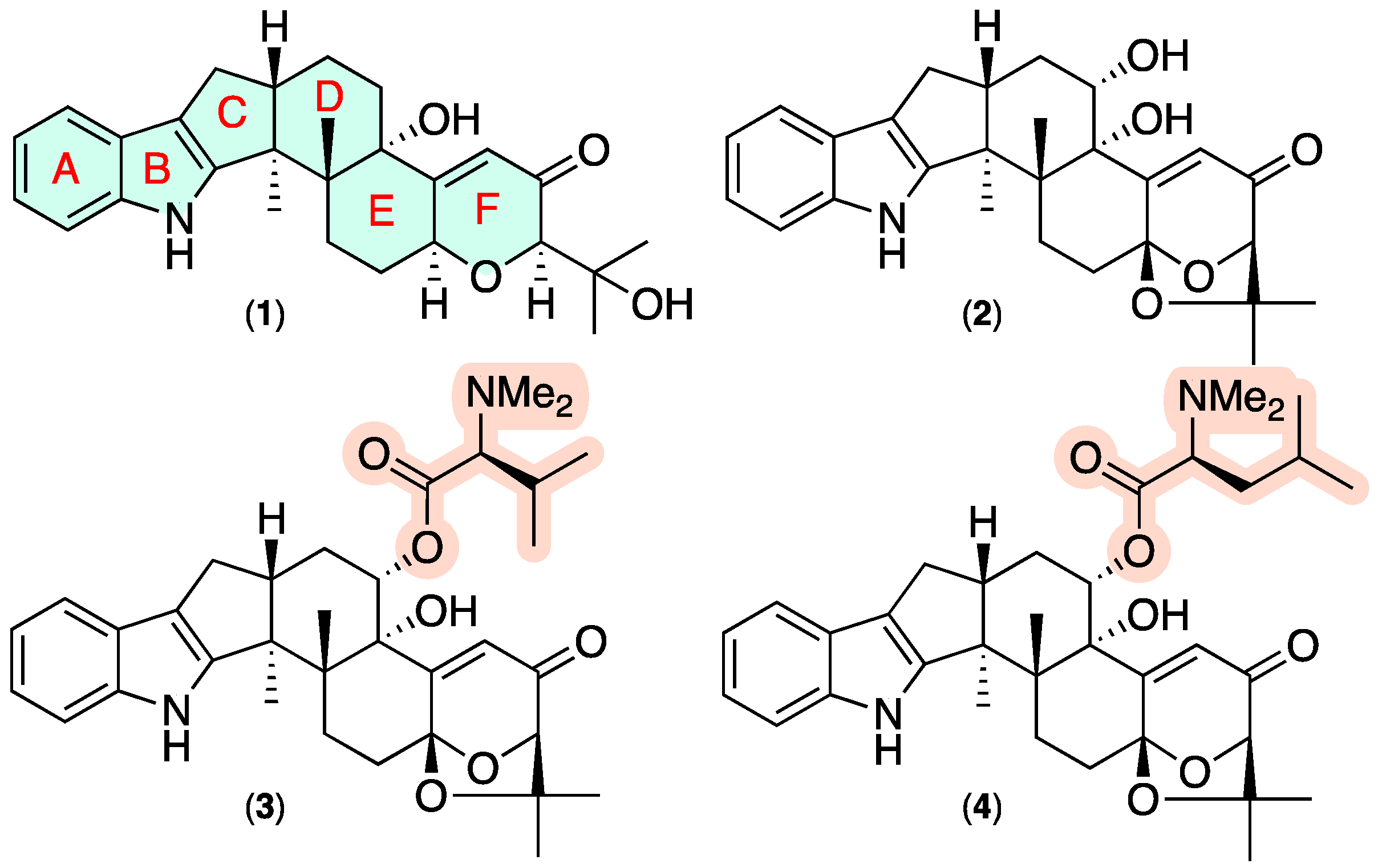

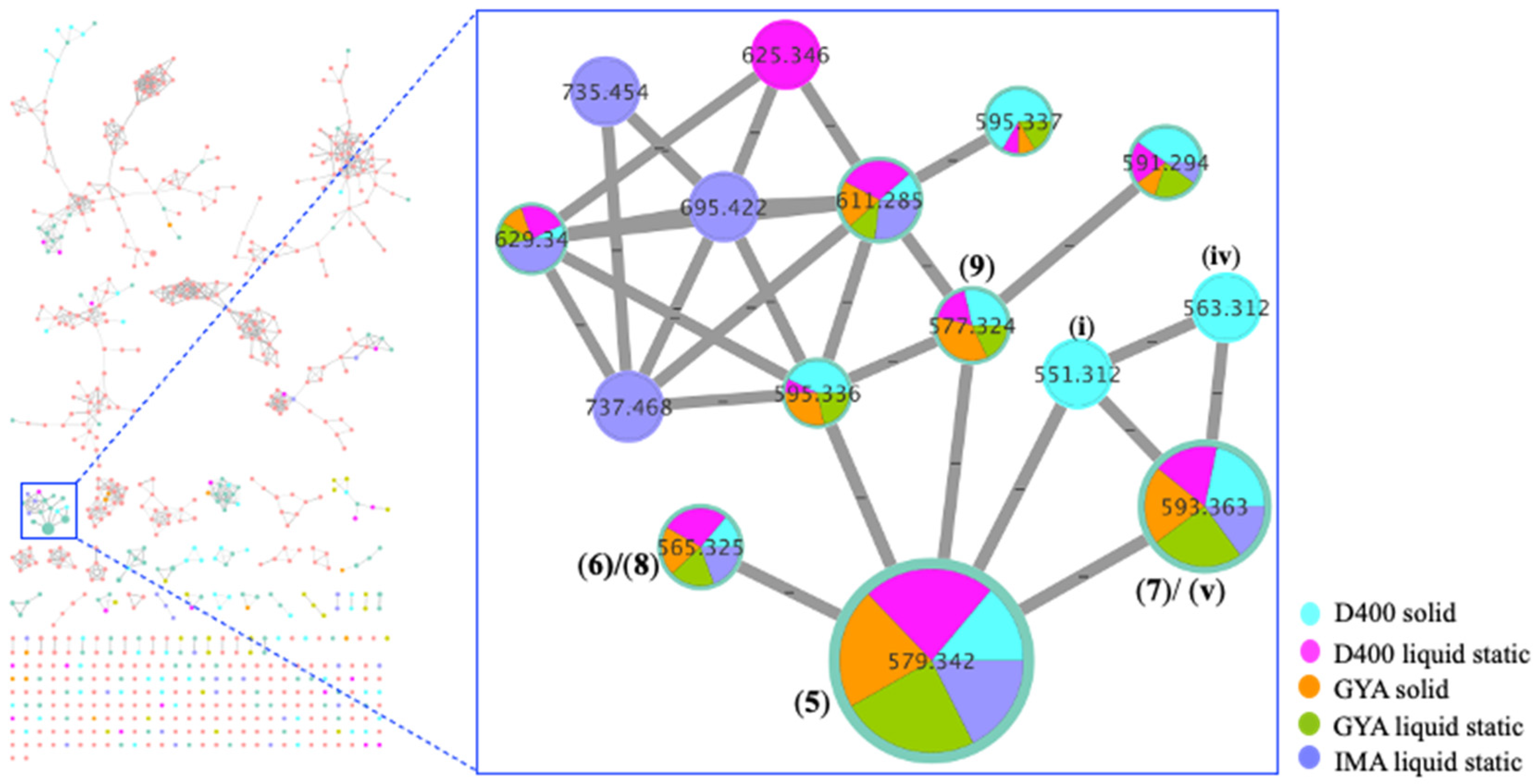
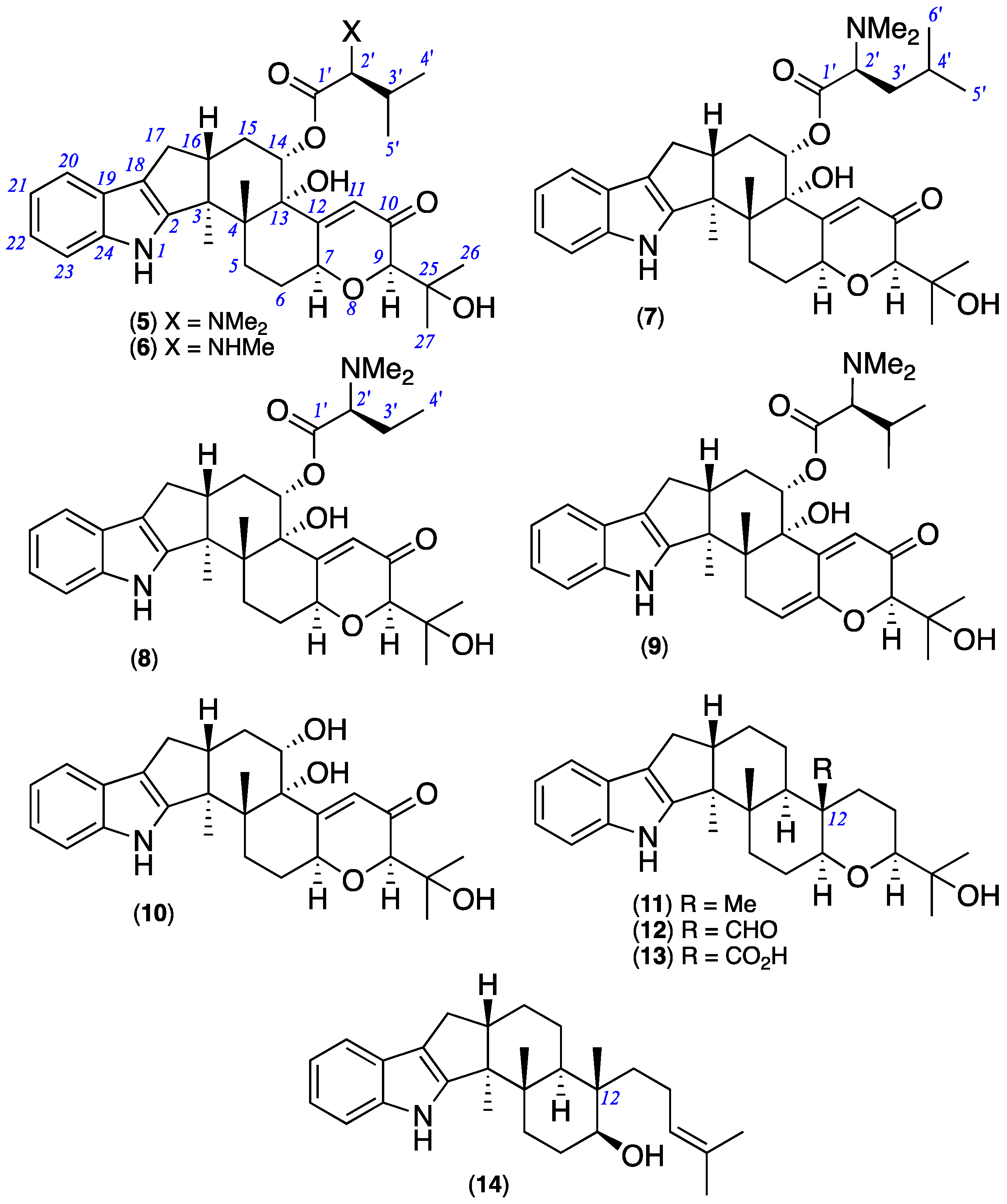
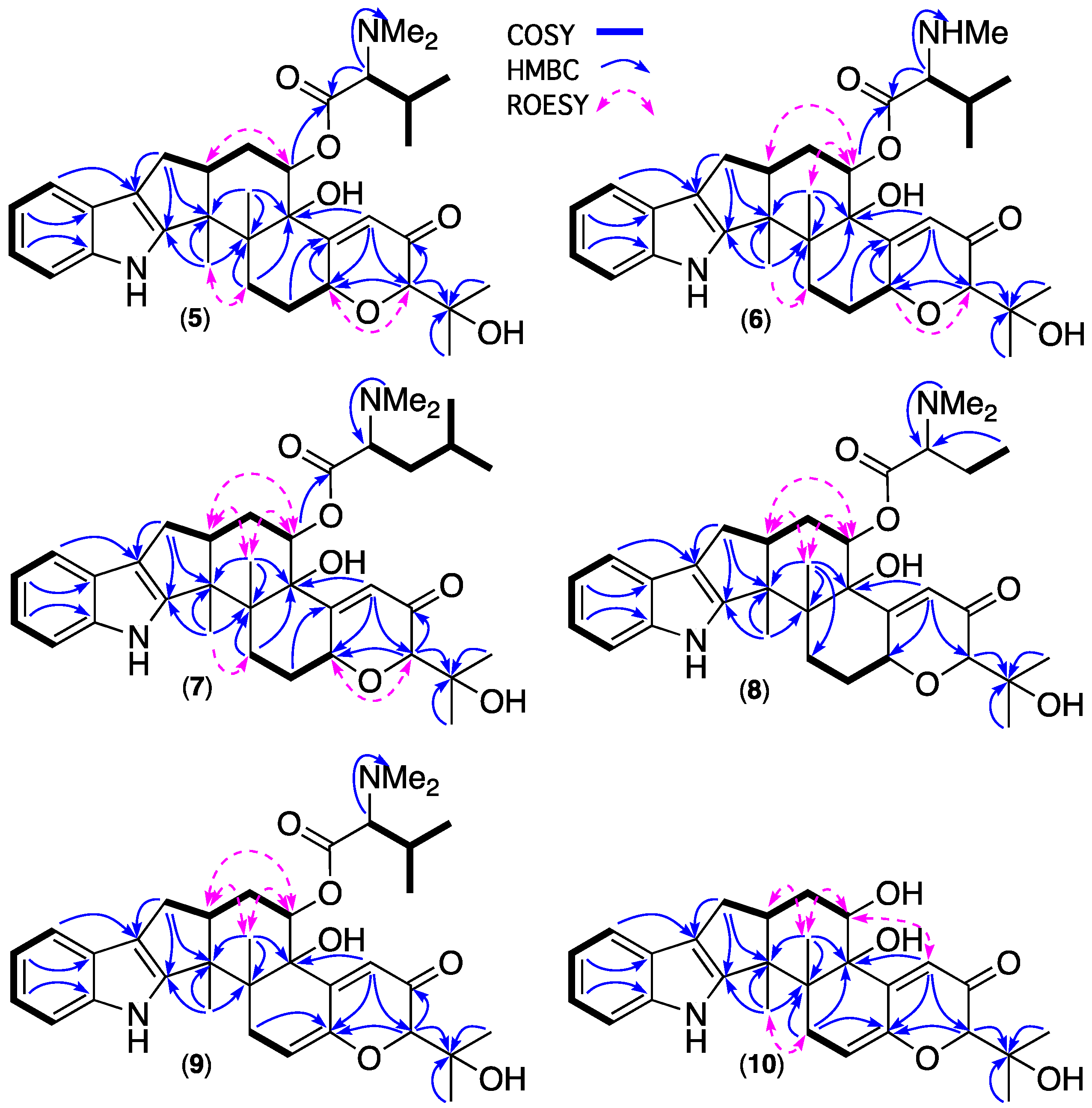

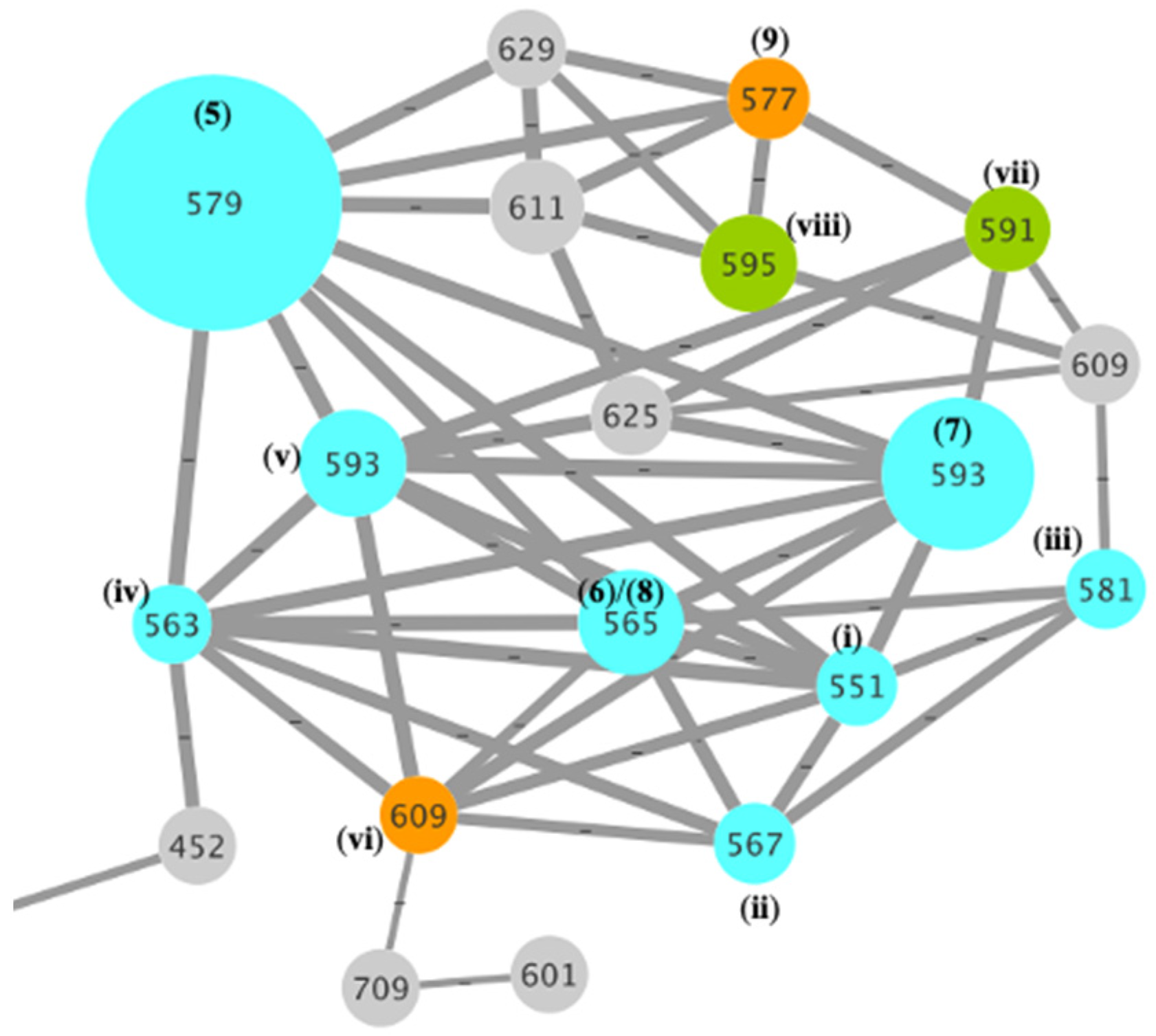

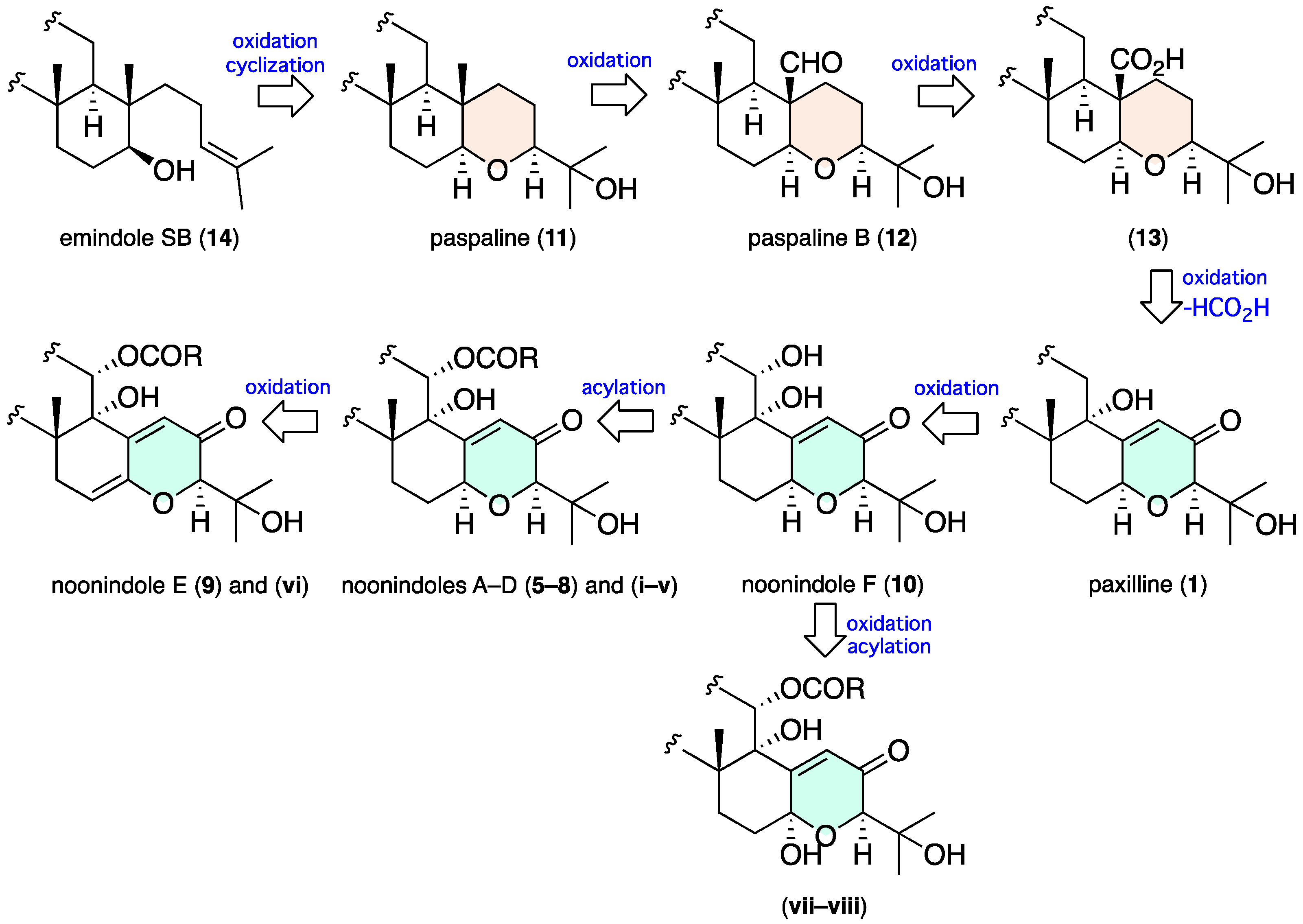
| Pos. | (5) δH, mult. (J in Hz) | δC | (6) δH, mult. (J in Hz) | δC | (7) δH, mult. (J in Hz) | δC |
|---|---|---|---|---|---|---|
| 2 | - | 152.4 | - | 152.3 | - | 152.2 |
| 3 | - | 52.0 | - | 51.9 | - | 51.8 |
| 4 | - | 46.4 | - | 46.2 | - | 46.2 |
| 5 | a 2.87, ddd (13.6, 13.6, 5.2) b 1.81, br dd (13.6, 5.2) | 28.1 | a 2.88, ddd (13.5, 13.5, 5.1) b 1.83, br dd (13.5, 5.1) | 28.0 | a 2.87, ddd (13.8, 13.8, 5.4) b 1.84, br dd (13.8, 5.4) | 27.9 |
| 6 | a 2.38, m b 1.91, m | 30.6 | a 2.39, m b 1.93, m | 30.5 | a 2.39, m b 1.93, m | 30.5 |
| 7 | 4.91, m | 74.6 | 4.90, m | 74.8 | 4.92, br t (8.5) | 74.8 |
| 9 | 3.68, d (1.9) | 84.0 | 3.72, d (1.5) | 83.9 | 3.71, br s | 84.0 |
| 10 | - | 198.5 | - | 198.1 | - | 197.9 |
| 11 | 5.62, d (1.9) | 122.4 | 5.57, d (1.5) | 122.0 | 5.57, d (1.9) | 121.8 |
| 12 | - | 165.9 | - | 165.8 | - | 165.0 |
| 13 | - | 80.0 | - | 80.0 | - | 80.1 |
| 14 | 5.53, dd (10.2, 5.3) | 77.9 | 5.50, dd (10.4, 5.0) | 77.3 | 5.51, dd (10.4, 5.1) | 77.5 |
| 15 | a 2.24, dd (11.1, 10.2) b 2.21, m | 28.5 | a 2.25, dd (13.0, 10.4) b 2.17, m | 28.3 | a 2.25, dd (13.2, 10.4) b 2.20, m | 28.1 |
| 16 | 2.92, m | 47.4 | 2.98, m | 47.5 | 2.97, m | 47.5 |
| 17 | a 2.73, dd (13.0, 6.2) b 2.47 a, m | 27.6 | a 2.74, dd (13.1, 6.3) b 2.47, dd (13.1, 11.1) | 27.6 | a 2.74, dd (13.0, 6.3) b 2.47, dd (13.0, 10.8) | 27.6 |
| 18 | - | 117.4 | - | 117.3 | - | 117.2 |
| 19 | - | 126.2 | - | 126.0 | - | 126.1 |
| 20 | 7.31, d (7.5) | 119.0 | 7.30, d (7.9) | 118.8 | 7.30, d (7.8) | 118.9 |
| 21 | 6.94, ddd (7.5, 7.5, 1.1) | 120.1 | 6.93, br dd (7.9, 7.7) | 119.9 | 6.93, ddd (7.8, 7.8, 1.1) | 119.9 |
| 22 | 6.98, ddd (7.5, 7.5, 1.1) | 121.1 | 6.97, ddd (7.9, 7.9, 0.9) | 121.1 | 6.98, ddd (7.8, 7.8, 1.1) | 121.1 |
| 23 | 7.27, d (7.5) | 112.7 | 7.28, d (7.9) | 112.7 | 7.28, d (7.8) | 112.7 |
| 24 | - | 141.8 | - | 141.9 | - | 141.9 |
| 25 | - | 73.3 | - | 73.0 | - | 73.0 |
| 26 | 1.28, s | 25.4 | 1.28, s | 25.3 | 1.30, s | 25.5 |
| 27 | 1.26, s | 26.2 | 1.26, s | 26.4 | 1.27, s | 25.8 |
| 1′ | - | 167.4 | - | 168.9 | - | 168.9 |
| 2′ | 3.86, d (5.5) | 74.8 | 3.90, br s | 68.7 | 4.02, m | 67.5 |
| 3′ | 2.47 a, m - | 28.4 - | 2.31, m - | 30.7 - | a 1.90, m b 1.69, m | 37.4 37.4 |
| 4′ | 1.05 b | 19.4 | 1.09, br d (5.3) | 18.7 | 1.56, m | 26.2 |
| 5′ | 1.03, d (7.1) | 17.0 | 0.99, d (7.0) | 17.7 | 0.97, d (6.4) | 23.4 |
| 6′ | - | - | - | - | 0.91, d (6.4) | 21.4 |
| 3-Me | 1.37, s | 16.7 | 1.37, s | 16.6 | 1.38, s | 16.6 |
| 4-Me | 1.04 b | 19.4 | 1.10, s | 19.5 | 1.09, br s | 19.4 |
| NHMe | - | - | 2.72, s | 33.8 | - | - |
| NMe2 | 2.90, s | 43.0 | - | - | 2.93, s | 42.1 |
| Pos. | (8) δH, mult. (J in Hz) | δC | (9) δH, mult. (J in Hz) | δC | (10) δH, mult. (J in Hz) | δC |
|---|---|---|---|---|---|---|
| 2 | - | 151.1 | - | 152.5 | - | 152.9 |
| 3 | - | 50.5 | - | 51.9 | - | 51.8 |
| 4 | - | 44.6 | - | 46.2 | - | 44.7 |
| 5 | a 2.87 a, m b 1.80, m | 28.0 | a 3.28 * b 2.36, d (6.3) | 33.0 | a 2.80, ddd (13.5, 13.5, 5.1) b 1.79, dd (13.5, 5.1) | 28.1 |
| 6 | a 2.37, m b 1.91, m | 30.4 | 5.74, m | 113.5 | a 2.33, m b 1.90, m | 30.2 |
| 7 | 4.90, m | 74.6 | - | 146.4 | 4.88, m | 74.7 |
| 9 | 3.71, d (1.9) | 83.7 | 4.09, s | 87.6 | 3.78, d (1.5) | 84.0 |
| 10 | - | nd | - | 196.8 | - | 200.0 |
| 11 | 5.58, d (1.9) | 121.7 | 5.71, br s | 119.5 | 6.01, br s | 122.9 |
| 12 | - | nd | - | nd | - | 167.5 |
| 13 | - | 78.9 | - | 77.8 | - | 80.8 |
| 14 | 5.37, dd (10.6, 5.1) | 74.4 | 5.41, dd (9.8, 5.8) | 75.5 | 4.16, dd (10.5, 4.9) | 70.3 |
| 15 | a 2.16, m b 2.04, ddd (7.1, 5.1, 2.3) | 28.4 | 2.18, m | 30.0 | a 2.08, dd (13.3, 10.5) b 1.93, m | 31.7 |
| 16 | 2.95, m | 47.0 | 2.90, m | 47.5 | 2.90, m | 48.0 |
| 17 | a 2.72, dd (13.1, 6.4) b 2.45, dd (13.1, 10.7) | 27.5 | a 2.72, dd (13.0, 6.5) b 2.44, dd (13.0, 10.8) | 28.0 | a 2.68, dd (13.0, 6.1) b 2.42, dd (13.0, 10.0) | 27.8 |
| 18 | - | 116.8 | - | 117.4 | - | 117.4 |
| 19 | - | 124.7 | - | 126.2 | - | 126.2 |
| 20 | 7.30, d (7.7) | 118.6 | 7.30, d (7.2) | 119.1 | 7.29, d (7.6) | 118.8 |
| 21 | 6.92, ddd (7.7, 7.3, 0.9) | 119.6 | 6.93, m | 120.0 | 6.92, br dd (7.6, 7.2) | 119.8 |
| 22 | 6.97, ddd (8.1, 7.3, 0.9) | 120.7 | 6.97, m | 121.2 | 6.95, br dd (7.4, 7.2) | 120.9 |
| 23 | 7.27, d (8.1) | 112.4 | 7.27, d (7.5) | 112.8 | 7.26, d (7.4) | 112.7 |
| 24 | - | 140.4 | - | 142.1 | - | 141.8 |
| 25 | - | 71.6 | - | 75.6 | - | 73.2 |
| 26 | 1.28, s | 25.1 | 1.33, s | 27.1 a | 1.29, s | 25.2 |
| 27 | 1.26, s | 25.9 | 1.26, s | 27.1 a | 1.27, s | 26.2 |
| 1′ | - | nd | - | nd | - | - |
| 2′ | 2.87 a, m | 72.9 | 2.86, d (9.4) | 76.0 | - | - |
| 3′ | a 1.77, m b 1.69, m | 23.8 | 2.11, m | 28.7 | - - | - - |
| 4′ | 0.91, t (7.4) | 10.1 | 0.97, t (7.4) | 19.9 | - | - |
| 5′ | - | - | 0.97, t (7.4) | 19.9 | - | - |
| 3-Me | 1.37, s | 16.3 | 1.40, s | 16.9 | 1.32, s | 16.5 |
| 4-Me | 1.08, s | 19.4 | 1.14, s | 21.0 | 1.04, s | 19.6 |
| NMe2 | 2.26, s | 43.4 | 2.34, s | 42.4 | - | - |
 | |||
| X (ester) | (a) | (b) | (c) |
| N,N-dimethyl-valine | (5) | (9) | (viii) |
| N-methyl-valine | (6) | - | - |
| N,N-dimethyl-leucine | (7) | (vii) | (vi) |
| N,N-dimethyl-homoalanine | (8) | - | - |
| N,N-dimethyl-alanine A | (i) | - | - |
| N,N-dimethyl-serine B | (ii) | - | - |
| N,N-dimethyl-threonine | (iii) | - | - |
| N-methyl-proline C | (iv) | - | - |
| N,N-dimethyl-isoleucine D | (v) | - | - |
Publisher’s Note: MDPI stays neutral with regard to jurisdictional claims in published maps and institutional affiliations. |
© 2022 by the authors. Licensee MDPI, Basel, Switzerland. This article is an open access article distributed under the terms and conditions of the Creative Commons Attribution (CC BY) license (https://creativecommons.org/licenses/by/4.0/).
Share and Cite
Kankanamge, S.; Khalil, Z.G.; Bernhardt, P.V.; Capon, R.J. Noonindoles A–F: Rare Indole Diterpene Amino Acid Conjugates from a Marine-Derived Fungus, Aspergillus noonimiae CMB-M0339. Mar. Drugs 2022, 20, 698. https://doi.org/10.3390/md20110698
Kankanamge S, Khalil ZG, Bernhardt PV, Capon RJ. Noonindoles A–F: Rare Indole Diterpene Amino Acid Conjugates from a Marine-Derived Fungus, Aspergillus noonimiae CMB-M0339. Marine Drugs. 2022; 20(11):698. https://doi.org/10.3390/md20110698
Chicago/Turabian StyleKankanamge, Sarani, Zeinab G. Khalil, Paul V. Bernhardt, and Robert J. Capon. 2022. "Noonindoles A–F: Rare Indole Diterpene Amino Acid Conjugates from a Marine-Derived Fungus, Aspergillus noonimiae CMB-M0339" Marine Drugs 20, no. 11: 698. https://doi.org/10.3390/md20110698
APA StyleKankanamge, S., Khalil, Z. G., Bernhardt, P. V., & Capon, R. J. (2022). Noonindoles A–F: Rare Indole Diterpene Amino Acid Conjugates from a Marine-Derived Fungus, Aspergillus noonimiae CMB-M0339. Marine Drugs, 20(11), 698. https://doi.org/10.3390/md20110698






